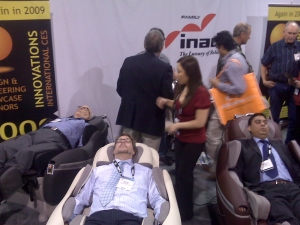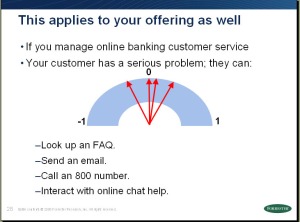I’m spending a few days at the Omniture Summit in Salt Lake City. Yesterday I was invited to speak on the topic of (what else?) video, along with Jeff Jordan from Omniture and Carmen Sutter of Warner Music. It was somewhat of a follow-up to an Omniture Webinar Jeff and I did in December.
It was a great session — Carmen shared some fabulous details about how they use video to keep fans connected to Warner Music artists. (Two fun facts worth sharing: 1) Fan-submitted videos represent a significant number of the videos on the artists’ sites, but account for only 5% of views, as Carmen explained it: “Fans came to see the bands, not each other.”; 2) People who use the audio player on the site rarely ever also watch videos, she attributed it to an age thing, the bands that attract young audiences have fans that want to watch stuff, the bands with more aged followers have fans that have yet to catch on to video but understand streaming audio.)
In the Q&A someone raised the very valid point that everyone’s talking about how video is the next big thing, but nobody’s talking about how hard and expensive it is to produce decent-quality video.
That’s a question I’m uniquely positioned to answer because I paid my way through my (first) grad school by being a video production guy and later video editor at a traditional analog video edit suite. I’ll skip the nerdy details, but I know a lot about how hard it is to shoot good video on the cheap.
I answered the question by saying that it’s true that good video is costly to produce. However, there is a subtle way to at least minimize cost and that is by identifying what “personality” you want your videos to convey. Once you have a style and a personality that your videos will adhere to, it removes a lot of the uncertainty in the production process. Reduced uncertainty=more manageable costs. The Blendtec guy is probably the easiest example to cite: once he decided that his approach was the mock-serious lab coat in front of a locked-down camera, that settled all the production decisions from there forward. (Never mind that it costs him a few hundred dollars to blend an iPhone.)
The second point to come out of that discussion was that by having a distinct personality, you train your viewers to expect that from you and you build the likelihood that — for those who like the personality you conveyed — they’ll want to return to see more. This, by the way, is exactly what major Hollywood producers and directors do. You’ve seen one J.J. Abrams piece, you’ve seen them all (or, in my case, you’ll want to see them all).
Anyway, it’s great timing to be talking about who has what it takes to become a video producer because Daisy Whitney at TV Week did her New Media Minute about this very topic, showcasing a variety of Internet video projects that try to do exactly this. Watch and learn — thanks for sharing, Daisy!
Vodpod videos no longer available.


 Posted by James
Posted by James 


You must be logged in to post a comment.